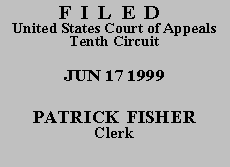

| ALBERTO LOPEZ, JR.,
Petitioner-Appellant, v. THOMAS UDALL, New Mexico Attorney General, Respondent-Appellee. |
|
Petitioner Alberto Lopez, Jr. appeals from the district court's dismissal of his second habeas petition, filed under 28 U.S.C. § 2254 in 1992, which challenges his state conviction for aggravated assault on a peace officer. Our jurisdiction arises under 28 U.S.C.§ 1291, and we affirm.
When reviewing the dismissal of a habeas petition on the ground that the petition constitutes an abuse of the writ, we review the district court's factual findings for clear error and its legal conclusions de novo. See Green v. Reynolds, 57 F.3d 956, 957 (10th Cir. 1995). Petitioner fully discharged his sentence, including his probationary term, in 1994. Respondent concedes, however that the case is not moot. See Carafas v. LaVallee, 391 U.S. 234, 237 (1968) (holding that a petitioner released from custody may continue to seek the writ if collateral consequences--lingering disabilities or burdens resulting from the conviction--are sufficient to give the petitioner "a substantial stake in the judgment of conviction which survives the satisfaction of the sentences imposed on him") (quotation omitted).
Because this was a second habeas petition, petitioner bore the burden of either showing "cause for the failure to raise the claim in an earlier habeas petition, and prejudice therefrom," Andrews v. Deland, 943 F.2d 1162, 1171 (10th Cir. 1991), or presenting evidence of actual innocence supported by "new reliable evidence . . . that was not presented at trial," Schlup v. Delo, 513 U.S. 298, 324 (1995). This evidence had to be sufficient to establish "that it is more likely than not that no reasonable juror would have convicted him in light of the new evidence." Id. at 327. After fully examining the state court record, the district court found that petitioner had not met either burden and that his petition was therefore barred for abuse of the writ.
On appeal, petitioner argues that the district court "failed to weigh the probative force" of statements made in an incident report that petitioner claims prove that he was unarmed during his confrontation with the officer he was convicted of assaulting. Appellant's Br. at 17. We disagree. The report that petitioner claims is inconsistent with the officer's trial testimony states that, while petitioner was threatening that he and his men would shoot the officer unless he left the area, petitioner was reaching for his shotgun. See R. Doc. 10, ex. D, at 1. The incident interview states that at the time of the threat, one of petitioner's men had a rifle in his hands, and by the time the officer backed approximately fifty feet down the street, petitioner had picked up his shotgun and had moved to the middle of the street. See id. at 6-7. Petitioner's theory of innocence is based on timing: i.e., because the incident report states that he did not have the shotgun in his hands at the exact time he made the threat to shoot, it proves he is actually innocent of aggravated assault. Clearly, the confrontation between petitioner and the officer did not end immediately when petitioner's threat was uttered; the record reflects that petitioner refused to lay down his gun until the state police arrived. See id. Petitioner admits that he was armed with the shotgun during the confrontation; and petitioner was certainly capable of shooting the officer with the shotgun from a distance of fifty feet. In the same incident report, the officer reported being in immediate fear of a "shoot out." See id. at 9. The district court did not fail to properly weigh the "probative force," if any, of the report, and correctly determined that petitioner failed to establish either actual innocence or any ineffective assistance of counsel in not focusing on this report or on alleged inconsistency regarding timing between the report and the officer's testimony at trial.
The judgment of the United States District Court for the District of New Mexico is AFFIRMED.
Entered for the Court
Senior District Judge
*. This order and judgment is not binding precedent, except under the doctrines of law of the case, res judicata, and collateral estoppel. The court generally disfavors the citation of orders and judgments; nevertheless, an order and judgment may be cited under the terms and conditions of 10th Cir. R. 36.3.
**. Honorable Wesley E. Brown, Senior District Judge, United States District Court for the District of Kansas, sitting by designation.